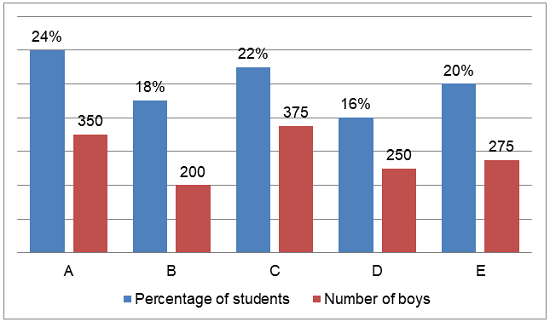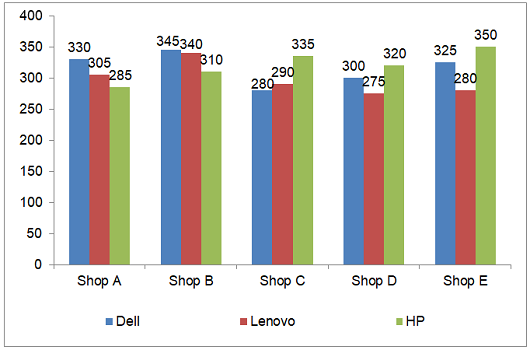Bar Graph For SSC CGL: The Bar Graph For SSC CGL is one of the easy and important topics in the Quantitative Aptitude section of the SSC CGL Exam. If we analyze the previous year’s SSC CGL Exam Paper then we can conclude that it consists of 4-6 questions at an easy to moderate level. In this blog, we have provided some important and different types of questions regarding the Bar Graph For SSC CGL Exam along with the answers. Candidates are advised to practice this topic very sincerely by which they can score good marks.
Concept of Bar Graph
A Bar Graph is a mathematical concept that can be defined as a graphical representation of data, numbers, or quantities using bars (rectangular shapes) or strips. It displays data in the form of rectangular bars which tells us the height proportionate to the values they represent.
Important Questions for Bar Graph with Solutions
In this section, we have provided the important questions and different types of questions that can be asked in the SSC CGL Exam by analyzing previous year question papers related to Bar Graph with solutions.
Advantage
- We have provided questions by analyzing previous year’s question papers.
- Answers are provided to all questions with their solutions.
- Questions are provided in both languages English and Hindi.
- Explanation is provided for all questions in very simple steps.
Bar Graph Questions in the English Language
Question 1: The given bar graph shows the percentage distribution of students out of the total students in all the five colleges together and number of boys in each of the five different colleges. Total number of students is 2500.
Total number of students = Number of boys + Number of girls

Find the ratio of number of girls in college ‘A’ and ‘B’ together to the total number of students in college ‘E’.
A) 3:4
B) 8:7
C) 4:5
D) 1:1
Question 2: The given bar graph shows the percentage distribution of students out of total students in all the five colleges together and number of boys in each of the five different colleges. Total number of students is 2500.
Total number of students = Number of boys + Number of girls

The average number of boys in college ‘A’, ‘B’ and ‘E’ is how much percent more/less than the average number of girls in college ‘B’ and ‘D’?
A) 37.5%
B) 28.25%
C) 42.15%
D) 25.85%
Question 3: The given bar graph shows the percentage distribution of students out of total students in all the five colleges together and number of boys in each of the five different colleges. Total number of students is 2500.
Total number of students = Number of boys + Number of girls

Find the difference between total number of students in college ‘B’, ‘C’ and ‘D’ together and the number of girls in college ‘A’, ‘D’ and ‘E’ together.
A) 850
B) 775
C) 625
D) 600
Question 4: The given bar graph shows the percentage distribution of students out of total students in all the five colleges together and number of boys in each of the five different colleges. Total number of students is 2500.
Total number of students = Number of boys + Number of girls

The number of girls in college ‘B’ is what fraction of total number of boys in all the five colleges together?
A) 3/25
B) 2/17
C) 5/29
D) 4/15
Question 5: The given bar graph shows the percentage distribution of students out of total students in all the five colleges together and number of boys in each of the five different colleges. Total number of students is 2500.
Total number of students = Number of boys + Number of girls

Find the sum of total number of boys in college ‘A’, ‘C’ and ‘E’ and total number of students in college ‘B’ and ‘D’ together.
A) 1850
B) 1500
C) 2250
D) 1000
Question 6: The bar graph given below shows the number of Laptop sold by five different shops of three different brands.

What is the difference between the number of laptops sold by shop A and B together of Dell and the number of laptops sold by shop C and E of Lenovo?
A) 105
B) 125
C) 90
D) 140
Question 7: The bar graph given below shows the number of Laptop sold by five different shops of three different brands.

The number of laptops sold by shop B of Dell is what percentage of the number of laptops sold by shop A of all three companies?
A) 22.5%
B) 37.5%
C) 27.5%
D) 32.5%
Question 8: The bar graph given below shows the number of Laptop sold by five different shops of three different brands.

What is the average of the number of laptop sold by all shops of HP?
A) 350
B) 320
C) 335
D) 290
Question 9: The bar graph given below shows the number of Laptop sold by five different shops of three different brands.

What is the ratio of the number of laptops sold by shop C of Dell and Lenovo together to the number of laptops sold by shop D and shop E of Lenovo?
A) 21:23
B) 19:17
C) 25:24
D) 38:37
Question 10: The bar graph given below shows the number of Laptop sold by five different shops of three different brands.

What is the total number of Lenovo laptops sold by all shops together?
A) 1450
B) 1390
C) 1350
D) 1490
Bar Graph Questions in the Hindi Language
प्रश्न 1: दिए गए bar graph में सभी पांच colleges में कुल छात्रों में से छात्रों के प्रतिशत वितरण और पांच अलग-अलग colleges में से प्रत्येक में लड़कों की संख्या को दर्शाया गया है। छात्रों की कुल संख्या 2500 है।
छात्रों की कुल संख्या = लड़कों की संख्या + लड़कियों की संख्या

College ‘A’ और ‘B’ में लड़कियों की संख्या और college ‘E’ में कुल छात्रों की संख्या का अनुपात ज्ञात करें?
A) 3:4
B) 8:7
C) 4:5
D) 1:1
प्रश्न 2: दिए गए bar graph में सभी पांच colleges में कुल छात्रों में से छात्रों के प्रतिशत वितरण और पांच अलग-अलग colleges में से प्रत्येक में लड़कों की संख्या को दर्शाया गया है। छात्रों की कुल संख्या 2500 है।
छात्रों की कुल संख्या = लड़कों की संख्या + लड़कियों की संख्या

College ‘A’, ‘B’ और ‘E’ में लड़कों की औसत संख्या college’B’ और ’D’ की लड़कियों की औसत संख्या से कितने प्रतिशत अधिक / कम है?
A) 37.5%
B) 28.25%
C) 42.15%
D) 25.85%
प्रश्न 3: दिए गए bar graph में सभी पांच colleges में कुल छात्रों में से छात्रों के प्रतिशत वितरण और पांच अलग-अलग colleges में से प्रत्येक में लड़कों की संख्या को दर्शाया गया है। छात्रों की कुल संख्या 2500 है।
छात्रों की कुल संख्या = लड़कों की संख्या + लड़कियों की संख्या

College ‘B’, ‘C’ और ‘D’ में छात्रों की कुल संख्या और college ‘A’, ‘D’ और ‘E’ में लड़कियों की कुल संख्या के बीच का अंतर ज्ञात करें?
A) 850
B) 775
C) 625
D) 600
प्रश्न 4: दिए गए bar graph में सभी पांच colleges में कुल छात्रों में से छात्रों के प्रतिशत वितरण और पांच अलग-अलग colleges में से प्रत्येक में लड़कों की संख्या को दर्शाया गया है। छात्रों की कुल संख्या 2500 है।
छात्रों की कुल संख्या = लड़कों की संख्या + लड़कियों की संख्या

College ‘B’ में लड़कियों की संख्या सभी पाँच कॉलेजों में कुल लड़कों की संख्या का कितना अंश है?
A) 3/25
B) 2/17
C) 5/29
D) 4/15
प्रश्न 5: दिए गए bar graph में सभी पांच colleges में कुल छात्रों में से छात्रों के प्रतिशत वितरण और पांच अलग-अलग colleges में से प्रत्येक में लड़कों की संख्या को दर्शाया गया है। छात्रों की कुल संख्या 2500 है।
छात्रों की कुल संख्या = लड़कों की संख्या + लड़कियों की संख्या

College ‘A’, ‘C’ and ‘E’ में कुल लड़कों की संख्या और college ‘B’ and ‘D’ में कुल छात्रों की संख्या का जोड़ ज्ञात करें?
A) 1850
B) 1500
C) 2250
D) 1000
प्रश्न 6: नीचे दिया गया bar graph तीन अलग-अलग brands की पांच अलग-अलग दुकानों द्वारा बेचे गए Laptop की संख्या दर्शाता है।

Shop A और B द्वारा बेची गई Dell laptops की संख्या और shop C और E द्वारा बेची गई Lenovo laptops की संख्या के बीच का अंतर ज्ञात करें?
A) 105
B) 125
C) 90
D) 140
प्रश्न 7: नीचे दिया गया bar graph तीन अलग-अलग brands की पांच अलग-अलग दुकानों द्वारा बेचे गए Laptop की संख्या दर्शाता है।

Shop B द्वारा बेचे जाने वाले Dell laptops की संख्या shop A द्वारा सभी तीन कंपनी द्वारा बेचे गए laptops की संख्या का कितना प्रतिशत है?
A) 22.5%
B) 37.5%
C) 27.5%
D) 32.5%
प्रश्न 8: नीचे दिया गया bar graph तीन अलग-अलग brands की पांच अलग-अलग दुकानों द्वारा बेचे गए Laptop की संख्या दर्शाता है।

सभी दुकानों द्वारा बेचे जाने वाले HP laptop की संख्या का औसत ज्ञात करें?
A) 350
B) 320
C) 335
D) 290
प्रश्न 9: नीचे दिया गया bar graph तीन अलग-अलग brands की पांच अलग-अलग दुकानों द्वारा बेचे गए Laptop की संख्या दर्शाता है।

Shop C द्वारा बेचे गए Dell और Lenovo laptops की संख्या और shop D और shop E द्वारा बेचे जाने वाले Lenovo laptops की संख्या का अनुपात ज्ञात करें?
A) 21:23
B) 19:17
C) 25:24
D) 38:37
प्रश्न 10: नीचे दिया गया bar graph तीन अलग-अलग brands की पांच अलग-अलग दुकानों द्वारा बेचे गए Laptop की संख्या दर्शाता है।

सभी shops द्वारा एक साथ बेची गई Lenovo laptops की कुल संख्या कितनी है?
A) 1450
B) 1390
C) 1350
D) 1490
Bar Graph Solutions of Above Questions with Explanation
Solution 1: D)
Number of girls in college ‘A’ = 0.24 × 2500 – 350 = 250
Number of girls in college ‘B’ = 0.18 × 2500 – 200 = 250
Total number of students in college ‘E’ = 0.20 × 2500 = 500
Required ratio = (250 + 250):500 = 1:1
Hence, option d.
Solution 2: A)
Number of girls in college ‘B’ = 0.18 × 2500 – 200 = 250
Number of girls in college ‘D’ = 0.16 × 2500 – 250 = 150
Average number of girls in college ‘B’ and ‘D’ = (250 + 150)/2 = 200
Average number of boys in college ‘A’, ‘B’ and ‘E’ = (350 + 200 + 275)/3 = 275
Required percentage = {(275 – 200)/200} × 100 = 37.5%
Hence, option a.
Solution 3: B)
Total number of students in college ‘B’ = 0.18 × 2500 = 450
Total number of students in college ‘C’ = 0.22 × 2500 = 550
Total number of students in college ‘D’ = 0.16 × 2500 = 400
Number of girls in college ‘A’ = 0.24 × 2500 – 350 = 250
Number of girls in college ‘D’ = 400 – 250 = 150
Number of girls in college ‘E’ = 0.20 × 2500 – 275 = 225
Required difference = (450 + 550 + 400) – (250 + 150 + 225) = 775
Hence, option b.
Solution 4: C)
Number of girls in college ‘B’ = 0.18 × 2500 – 200 = 250
Total number of boys in all the five colleges = (350 + 200 + 375 + 250 + 275) = 1450
Required fraction = 250/1450 = 5/29
Hence, option c.
Solution 5: A)
Total number of boys in college ‘A’, ‘C’ and ‘E’ together = (350 + 375 + 275) = 1000
Total number of students in college ‘B’ and ‘D’ together = 0.18 × 2500 + 0.16 × 2500 = 850
Required sum = (1000 + 850) = 1850
Hence, option a.
Solution 6: A)
Required difference = (330 + 345) – (290 + 280)
= 675 – 570 = 105
Hence, option a.
Solution 7: B)
The number of laptops sold by shop A of all three companies = 330 + 305 + 285 = 920
Required percentage = 345/920 × 100 = 37.5%
Hence, option b.
Solution 8: B)
Required average = (285 + 310 + 335 + 320 + 350)/5 = 1600/5 = 320
Hence, option b.
Solution 9: D)
Required ratio = (280 + 290):(275 + 280) = 570:555 = 38:37
Hence, option d.
Solution 10: D)
Total number of Lenovo laptops sold by all shops together = 305 + 340 + 290 + 275 + 280 = 1490
Hence, option d.
Bar Graph For SSC CGL FAQs
Yes, the Bar Graph For SSC CGL provides questions in both Hindi and English Language.
Yes, we have provided solutions in the Bar Graph For SSC CGL along with the explanations.
A Bar Graph is a graphical representation of data, numbers, or quantities using bars (rectangular shapes) or strips.
- Sign Up on Practicemock for Updated Current Affairs, Free Topic Tests and Free Mini Mocks
- Sign Up Here to Download Free Study Material
Free Mock Tests for the Upcoming Exams
- IBPS PO Free Mock Test 2024
- RBI Grade B Free Mock Test 2024
- IBPS SO Free Mock Test 2024
- NABARD Grade A Free Mock Test 2024
- SSC CGL Free Mock Test 2024
- IBPS Clerk Free Mock Test 2024
- IBPS RRB PO Free Mock Test 2024
- IBPS RRB Clerk Free Mock Test 2024
- RRB NTPC Free Mock Test 2024
- SSC MTS Free Mock Test 2024
- SSC Strenographer Free Mock Test 2024
- GATE Mechanical Free Mock Test 2024
- GATE Civil Free Mock Test 2024
- RRB ALP Free Mock Test 2024
- SSC CPO Free Mock Test 2024
- AFCAT Free Mock Test 2024
- SEBI Grade A Free Mock Test 2024
- IFSCA Grade A Free Mock Test 2024
- RRB JE Free Mock Test 2024
- Free Banking Live Test
- Free SSC Live Test



